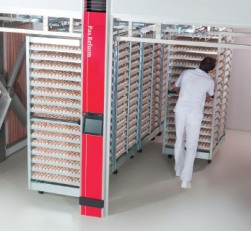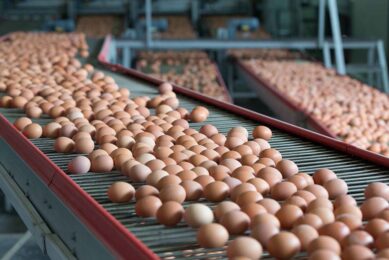Aerospace technology to produce robust chicks

Modern poultry producers prefer birds that equally and efficiently grow to their ideal processing weight. Hatchery managers are therefore expected to produce large numbers of uniform, robust day-old chicks that can easily cope with the harsh conditions of the production environment. Circadian incubation™ offers tools that have been designed with the help of aerospace technology.
By Wiebe van der Sluis
The role of hatchery managers in maximising broiler performance is much bigger than one may think. Breeding companies have worked hard to create a bird that has the potential to grow efficiently and uniformly. The modern broiler is resistant to stressful conditions and uses only small amounts of nutrients for the maintenance of its basic physiological system. These efficiency traits, however, can only be activated with the help of new technologies present in modern single-stage incubators.
Robust chicks
The concept of robustness was introduced by geneticists to describe the efficient, modern bird in more biological terms, and to include important traits for selection relating to animal health and welfare. Robustness is a health criterion that originates in embryonic life and correlates with growth and the resistance of the individual chicks under different farm conditions.
A robust day-old chick, therefore, is expected to deliver predictable growth and production under different farm designs and fluctuating environmental conditions. Batches of robust day-old chicks show low mortality, need less medication, and have the potential for optimum growth even under varying farm conditions.
To support the development of robust day-old chicks, hatchery manufacturer Pas Reform introduced the principle of circadian incubation at VIV Europe 2010. This concept has been incorporated in their new range of SmartPro™ incubators and is said to be the natural and progressive development of single-stage incubation.
“Circadian incubation includes embryonic ‘training’ or the imprinting of body functions during incubation to stimulate the chick’s robustness during grow-out. This ‘imprinting’ is achieved by exposing the embryo to environmental triggers during critical periods of the maturation of physiological control systems,” says Pas Reform CEO Bart Aangenendt. “Several scientific studies have shown that circadian incubation causes long-lasting alterations in the perinatal epigenetic programming of body functions.”
Short-term thermo-conditioning
In poultry, the best understood physiological system is the maturation of thermoregulation and its dependence on incubator temperatures. According to Aangenendt, their studies have shown that embryos exposed to short, controlled periods of heat or cold develop an improved capacity to control body temperature during periods of heat or cold in the farm. “Such daily short-term thermo-conditioning is at the heart of circadian incubation, and is known to improve hatchability for long-lasting effects that include 1-2% increase in final body weight and 1-2 points better feed conversion rates. Batches of uniform, robust day-old chicks also deliver uniformity at slaughter age, thereby improving processing yields, efficiency and performance throughout the entire production chain.”
To support the use of circadian incubation, the incubator must deliver precise climate control for every single egg. “To achieve such a truly homogeneous temperature distribution, it was our challenge to exchange energy, carbon dioxide and oxygen, and moisture without affecting temperature uniformity around the eggs,” says the Pas Reform CEO. “It took us several years of intensive research and development to meet the exact requirements.” As a result, the company uniquely combined three critical features in the new incubators: a modular design; a new Vortex™-based airflow principle, and; Adaptive Metabolic Feedback™.
Complete temperature homogeneity
Using a modular design allows the hatchery manager to create sectional environments of 19,200 eggs in the incubator that can be controlled individually. “This is the only way to guarantee a homogeneous egg temperature in incubators containing more than 100,000 hatching eggs,” says Aangenendt. “Each modular section is supported by its own temperature, heating, cooling, humidification, and ventilation systems, which uniquely enable the incubation of batches of eggs from different flocks and different ages altogether in the same machine without losing performance and results.”
To ensure homogeneity in temperature throughout the whole incubator, Pas Reform invested in the design of its air distribution concept. Through using Computational Fluid Dynamics (CFD), routinely applied in the aerospace and automotive industry, it was demonstrated that the most effective method of exchanging energy, CO2/O2 and moisture in the incubator, is to use air pump blades that generate as many vortices with a specific dimension and intensity as possible. A mixing zone ensures complete air temperature homogeneity before air is drawn over the eggs. The mixed air vortices flow in parallel with the turning direction of the setter trolleys to make sure that air direction along the eggs changes constantly to maintain a homogeneous eggshell temperature. This new ‘Vortex™’ airflow principle has shown its value during research and practical field studies.
Metabolic feedback
The third feature of Pas Reform’s new hatchery technology is Adaptive Metabolic Feedback™. ”The computer software has been developed to ensure that the incubation environment meets the metabolic needs of each growing embryo during its development. With a focus on managing moisture and carbon dioxide, the software continually ‘reads’ the time-varying metabolism of a specific batch of embryos to adapt control parameters and fine-tune the incubator environment according to the embryo’s needs. Ultimately it maximises uniformity by optimising airflow, the evaporation of moisture, and air redistribution. It prevents an excessive inlet of both dry and cold fresh air to maximise temperature homogeneity, and custom controls relative humidity set points for variable egg weight loss at each stage of embryonic development,” explains Aangenendt.
The combined use of these three features makes it possible to exchange energy, CO2/O2 and humidity without affecting homogeneous temperature around the eggs. This delivers significant advantages for the modern hatchery, including homogeneous egg temperature distribution in the maturation phase of incubation, says Aangenendt. Short, accurate stimuli in temperature for each of the embryos is possible, to deliver the benefits of Circadian incubation™ on hatchability, robustness, final body weight and feed conversion ratios of the broilers.
Join 31,000+ subscribers
Subscribe to our newsletter to stay updated about all the need-to-know content in the poultry sector, three times a week. Beheer
Beheer








 WP Admin
WP Admin  Bewerk bericht
Bewerk bericht